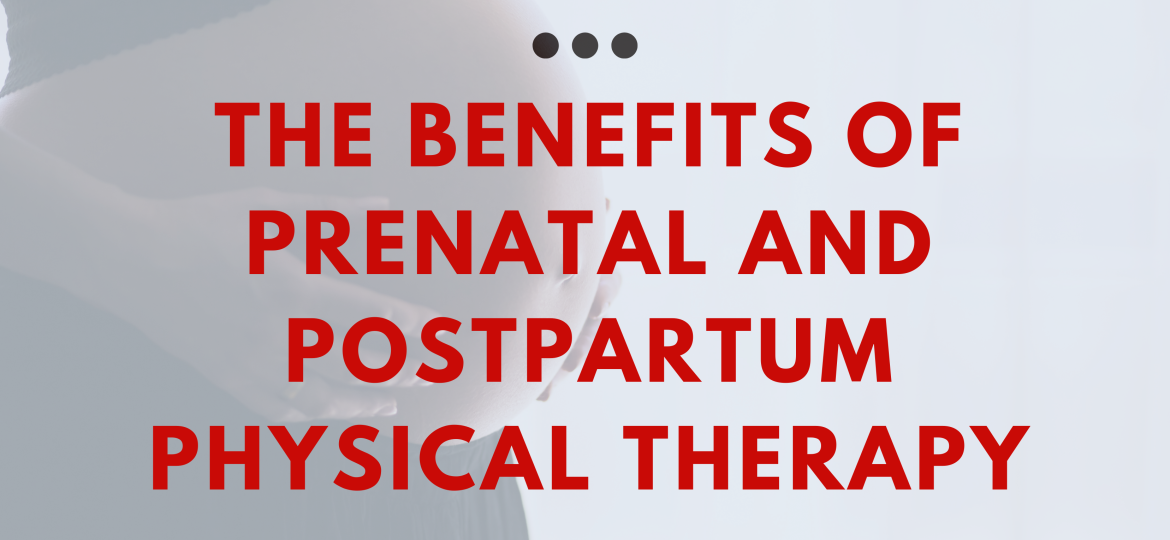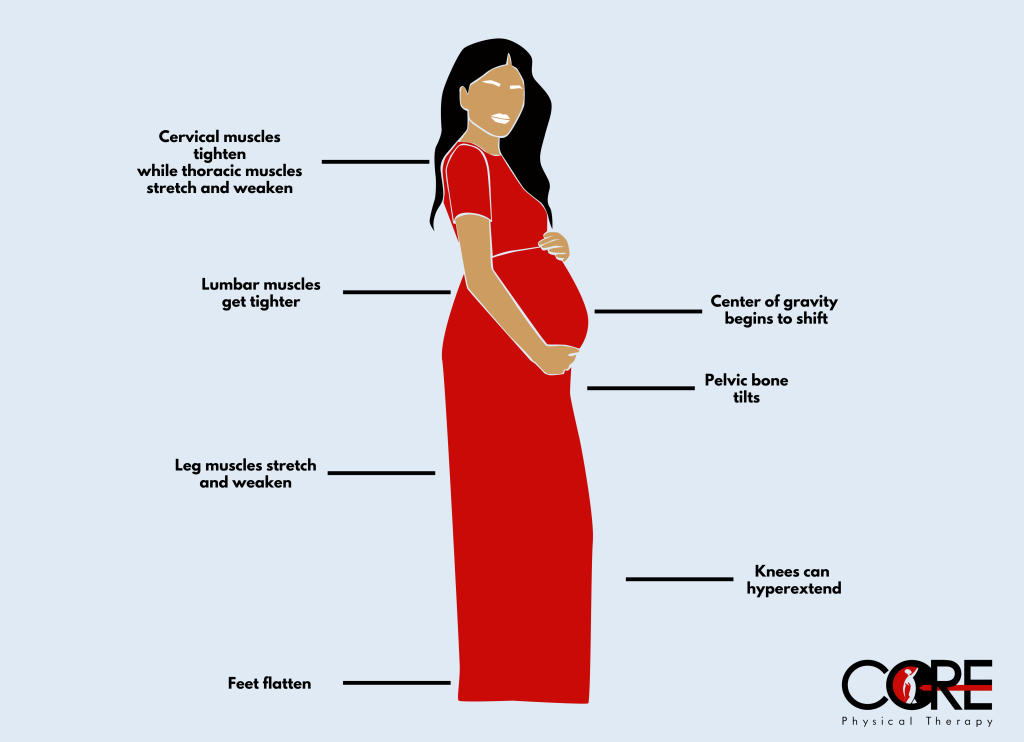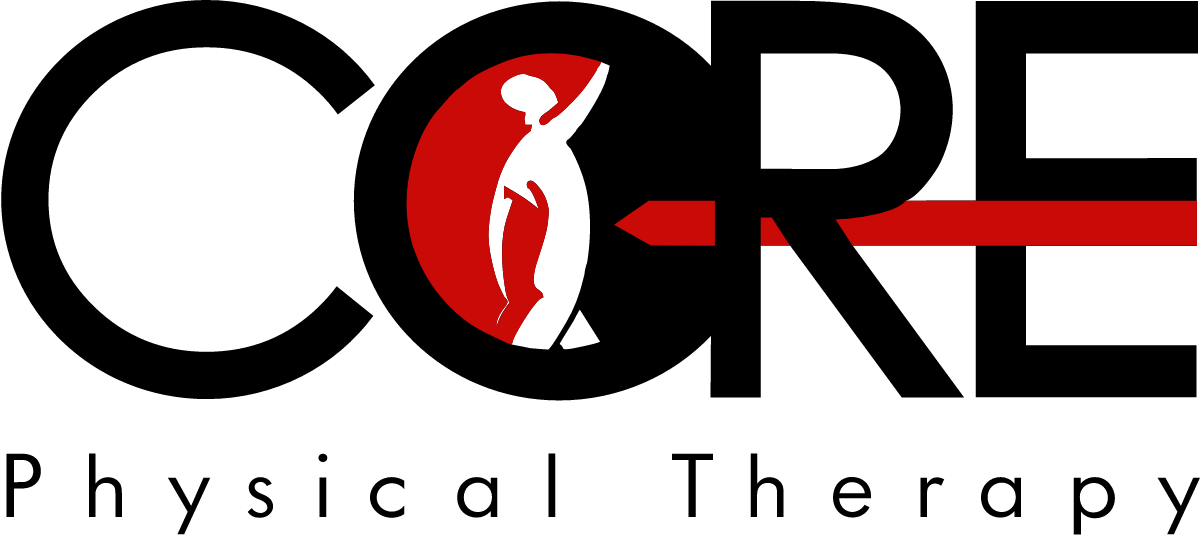
This blog post was written by Alex Spencer, a Core Physical Therapy PT who specializes in prenatal and postpartum patient care.
Congrats! You just found out you’re pregnant and are most likely experiencing a multitude of emotions. Whether it’s your first pregnancy or third, this is a time of anticipation and major changes for your body.
These changes can cause you to begin feeling aches and pains you may have never experienced before. But luckily, a trip to a physical therapist who specializes in pregnancy and postpartum pelvic health (like myself) can help to manage these pains and keep you as comfortable as possible through the entire process.
As your baby grows, rapid postural changes will occur due to weight gain and increased ligament laxity perpetuated by the fluctuation of hormones coursing through your body. These changes then lead to increased tension through our muscles as they are trying to provide stability for the ever-changing system.
The most common compensations I see in the clinic are shown in the image below. These all occur as the center of mass (aka your baby) moves outward.

Not only does your posture change, but as your baby grows and begins to descend down into the pelvic bowl to prepare for labor, the pelvic floor muscles begin to take on this load. Within the pelvic bowl also sits your bladder. Increased weight down into this area may lead to symptoms such as urinary leakage and/or feeling like you need to run to the bathroom every 10 minutes.
While this is not an extensive list of changes that can occur with pregnancy, they are the ones I see in the clinic most frequently.
Benefits of Prenatal (and Post-Partum) Physical Therapy
First and foremost, postural changes can arise with an ever-growing baby. Physical therapists who are specialized in pregnancy and postpartum rehabilitation are specialized to pick out, and subsequently address, the changes that occur through manual techniques and specialized exercise regimens.
By addressing these changes, we can help you have the most comfortable and enjoyable pregnancy as possible. Who wouldn’t want that? A systematic review of 1,284 research articles conducted by the Journal of Orthopaedic and Sports Physical Therapy concluded that a safe exercise regimen during pregnancy, that was developed by a trained physical therapist, can reduce low back pain and even lower the likelihood of these symptoms persisting after childbirth.
Many individuals will struggle with knowing what is “safe” to do during pregnancy. The question I frequently get is: are there any activities I should avoid? And as a physical therapy student, the most frustrating answer my professors could give me was “it depends”. But I am about to give that exact same answer to you, because it actually does depend.
It depends on your activity level prior to pregnancy, other health conditions, stage of pregnancy, current symptoms you are experiencing, and so much more. Based on all that information, a trained physical therapist can devise a plan to address your specific limitations. Not only will an exercise regimen help you feel your best physically, it can also help to prevent against conditions such as gestational diabetes.
A research study done by Sanabria- Martinez et. Al. in 2015 showed a “reduction in risk of GDM (gestational diabetes) is greater when the intervention includes combined exercises (31%). This finding could be because resistance training contributes to blood glucose uptake without altering the muscle capacity to respond to insulin, and aerobic exercise enhances its uptake via a greater insulin action”. Sanabria-Martinez Et al., 2015, p 1172. (study information taken from Pregnancy and Postpartum Corrective Exercise Specialist workbook by Sarah Duvall.)
The labor and delivery process is no easy feat. The more we can prepare your muscles and tissues prior to birth, the better both mom and baby will fare. Physical therapy intervention can help to increase your strength and flexibility, specifically through the hips and low back, to allow for easier passage of your baby through the pelvic girdle. We can also coach you through various techniques, such as perineal massage, to decrease risk of tearing during vaginal delivery.
While we can be by your side through the pregnancy process, I would highly recommend having a doula or midwife with you through the labor and delivery process. Having somebody there to coach you, and advocate for you, is worth every penny. Not only can physical therapy intervention help you maintain as much comfort and function through the pregnancy process as possible, our interventions can also improve your ability to recover postpartum. Nearly 100% of women will present with Diastasis Rectus Abdominus by the end of pregnancy. For those who are unfamiliar, I promise it’s not as scary as the name suggests.
It is a natural separation of the large rectus abdominus muscle (6-pack muscle) that occurs to help make room for baby to grow. By 6 weeks, 60% of women continue to present with this separation. Some women are able to heal independently without intervention. For those who don’t, I’m here for you. A skilled physical therapist will evaluate you postpartum to determine the best way in which to re-educate your abdominal and pelvic musculature to safely and effectively reduce separation between abdominal muscles and retrain proper function.
Besides DRA, physical therapists are experts in finding dysfunction and muscular imbalances that could lead to a multitude of other symptoms postpartum (neck, mid/low back pain, you name it). Once we find these specific dysfunctions our individual patient’s present with, we will create a treatment plan to get you back to prior level of function.
There is research that suggests up to 40% of women experience pelvic floor dysfunction during pregnancy. And many can develop pelvic floor dysfunction after childbirth. Symptoms I look for are:
- Diastasis Rectus Abdominus (DRA)
- Frequent urination
- Constipation
- Urinary leakage with coughing, sneezing, laughing, jumping, etc.
- Low back, hip, and tailbone pain
- Feelings of incomplete emptying of urine
- Pelvic organ prolapse
- Pain during intercourse or insertion of tampon
I will listen to patient reports, perform thorough evaluation (including internal pelvic floor examination) and give an individualized treatment plan to address what dysfunction is found to allow you to get back to your daily activities.
Not only can I help with the physical changes that occur throughout the process, I can help to provide peace of mind through education. Pregnancy is a time of many changes, and no one pregnancy is ever the same. No matter the questions, I can either answer it for you, or help guide you to somebody who knows the answer. Moral of the story, I HIGHLY suggest having a team of trusted medical providers (doula, midwife, chiropractor, OBGYN, mental health specialist, etc.) in your corner during this process. Don’t know anybody in these fields, just ask and I can happily refer you on.
So why can’t pregnant women just do their own research and watch videos of exercises online to get through pregnancy?
I totally understand. Making time for physical therapy may be difficult for some individuals. Between work and personal life, trying to fit another thing into your schedule may feel impossible, and Google-ing answers to all your questions might seem so much easier. But there are many rabbit holes you can get yourself into when researching online. Asking physical therapists who deal with these conditions day in and day out will provide you with the most up to date and relevant information.
On top of that, no one pregnancy (and subsequent postpartum recovery) looks the same. A specialized physical therapist can look at you individually and find what works best for YOUR body. The more personalized the treatment, the better outcomes you will experience. Besides that, at Core Physical Therapy, we specialize in craniosacral and myofascial release techniques, big words for hands- on/manual treatment, that you cannot replicate on yourself. These techniques help to decrease fascial and muscular restrictions throughout the body so that we function as one, well-oiled machine.
